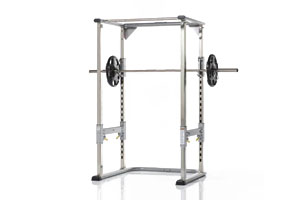
There are many advantages to strength training at home. And, if you’re lifting alone, using a rack or cage for your workouts is a must. Both power racks ans Smith machines are commonly chosen exercise tools, both in commercial as well as home gyms. Both power racks and Smith machines can be used for exercises such as squats, shoulder presses, and. bench presses. But, there are differences to each type of equipment, as well as advantages and disadvantages to each. Here’s how you tell the difference between a power rack and a Smith machine.
Smith machines, or Smith cages, were named after Rudy Smith, the gym owner who invented them. With a Smith machine, you have twin rods that guide your barbell, so it can move only in a vertical motion. There are also safety stops on the guide rails so you can set how far the bar will descent. In some cases, higher end machines don’t require a separate set of weight plates, as there are Smith machines that use a selectorized weight stack, incorporated into the machine. These are usually more expensive, and are less popular.
The main advantage to a smith machine is the guid rods eliminate the need for you to balance the barbell. You can focus purely on the lifting movement, as the bar only moves up and down. And, by twisting your wrist on the bar, you can lock the bar into place on the frame, so if you find yourself unable to lift the weight back to the top of the bar movement, you won’t be stuck under a heavy bar, increasing the safety of your lifts. Additionally, the bar is usually counterbalanced, so if you’re just starting out lifitng and can’t lift the weight of the 45 lb. bar, the weight you’ll actually be lifting is just the weight of the weights you place on the bar.
The disadvantage of a Smith machine is that since the bar movement is fixed, you don’t activate additional stabilizer muscles during your lift. And, if you were lifting the bar outside of the rack, your movement upward and downward is more of an arc than a straight line, a Smith machine may place additional stress on your joints. And, if one side of your body has less strength than the other, since the Smith machine’s movement doesn’t take into account the difference between left and right sides of your body, you may not strengthen the weak side as quickly as a free weight would.
Power racks are much simpler than Smith machines. With a power rack, you’re basically lifting within an open cage. You can set the horizontal bars to positions that will “catch” the bar, not allowing it to travel down below a certain position, so you get similar safety benefits that you get with a Smith machine. Otherwise, the barbell is free to move in any direction.
The advantages to a power rack, is that since your movement within the rack is much more unrestricted, you engage muscles that you woudn’t use with a Smith machine. This allows for a greater variety of exercises and workout routines. Additionally, many racks allow for the addition of optional attachmenents for dips and chin ups, adding to the machine’s versatility.
The disadvantage to a power rack is that if you can’t lift a standard, 45 lb Olympic barbell, you probably won’t be able to use a power rack. Power racks also tend to be tall, so your home gym may not have room to fit one. And for safety, they should be attached to the floor, which may not be possible in your home. Finally, unlike a Smith machine, since the movement is unrestricted, if you loose your balance or can’t lift the bar, you can’t “lock” it into the movement – you can only go down to where you set the safety rods.
At Fitness 4 Home Superstore, we carry a variety of power racks as well as Smith machines from a variety of manufacturers. Visit any of our three Phoenix area locations to learn more!

